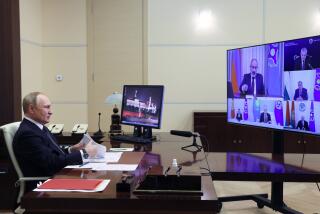Gorbachev May Visit Mexico, Italy in ’87
- Share via
MOSCOW — Fresh from a triumphal trip to India, Soviet leader Mikhail S. Gorbachev is considering travel to Italy, Greece, Mexico, Brazil, Argentina and Japan in 1987.
Unless Soviet-American relations improve remarkably in coming months, however, he probably will not make it to the United States next year, as proposed for a third summit session with President Reagan.
Gorbachev, who clearly enjoys his overseas outings, could become the most widely traveled Kremlin chief since the globe-trotting days of Nikita S. Khrushchev in the 1950s and early 1960s if he keeps up his present pace.
Energetic and articulate, Gorbachev presents himself as the leading champion of nuclear disarmament and a “new Soviet man” who wants to heal scars and divisions dating from the Cold War era.
In each of the four countries he has visited on foreign trips, Gorbachev has held a news conference with Soviet and selected Western correspondents to dramatize his new policy of glasnost , or public openness.
Gorbachev held news conferences at the summits with Reagan at Geneva and Reykjavik, Iceland. In contrast, the President held none during the meetings.
While glasnost establishes a new standard for Kremlin leaders, it has some disadvantages. In India, for example, Gorbachev was pressed by reporters from India, Pakistan and Saudi Arabia on why the Soviet Union was keeping an estimated 115,000 troops in Afghanistan after seven years of civil war. At times, he appeared at a loss for an answer.
Soviet sources said Gorbachev has invitations from many countries to make an official visit as he nears the end of his second year as general secretary of the Communist Party.
“But the main question always must be: Is there a reason to go?” said a Soviet official who accompanied Gorbachev on his four-day visit to New Delhi last week.
Domestic reform, along with spurring economic progress, apparently will take most of the Kremlin leader’s time during the coming year, which will mark the 70th anniversary of the Bolshevik’s seizure of power.
A High Profile
But he has achieved a high profile on the international scene with a series of “initiatives” seeking elimination of nuclear weapons by the year 2000 and an immediate halt in nuclear testing.
Soviet officials have said, however, that Gorbachev’s unilateral moratorium on nuclear blasts may not be renewed after its Dec. 31 expiration date since the United States has shown no interesting in joining it.
Even so, some Western diplomats said Gorbachev’s dramatic proposals at Reykjavik to destroy all nuclear weapons in the next 10 years gave him a public relations advantage over Reagan.
During his visit to India, Gorbachev managed to get Indian Prime Minister Rajiv Gandhi to endorse all of the Soviet stands on nuclear disarmament. Since India in the past has been an influential member of the Nonaligned Movement, it was a major success for Soviet diplomacy.
Soviet sources said Gorbachev’s next trip may be to Greece, the member of the North Atlantic Treaty Organization that probably has the closest ties with Moscow. If he goes there--possibly next April or May--the visit would be combined with a trip to Italy where he might pay a call on Pope John Paul II, another busy traveler.
Italy has the largest Communist Party in Western Europe and Gorbachev’s embrace of detente has increased Soviet popularity there despite the skepticism of the so-called Eurocommunists about past Kremlin authoritarianism.
Later in the year, he may depart on a trip to Mexico, and possibly Cuba, before visiting Brazil and Argentina, the two largest countries in South America. Both nations recently turned out military governments, and their new leaders are anxious to repair frayed ties with Moscow.
More to Read
Sign up for Essential California
The most important California stories and recommendations in your inbox every morning.
You may occasionally receive promotional content from the Los Angeles Times.











